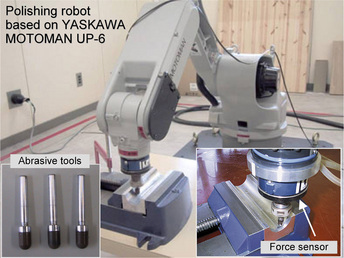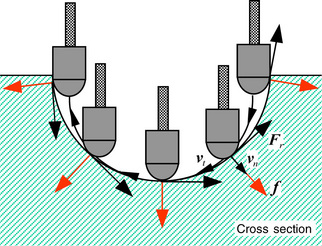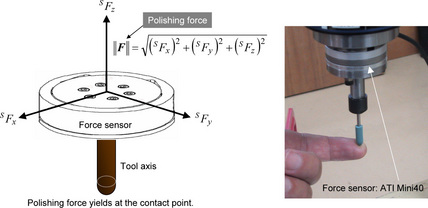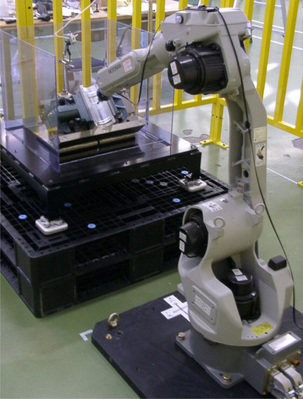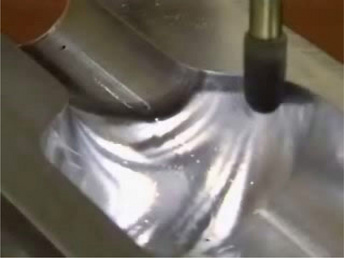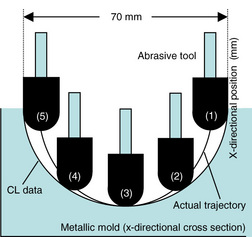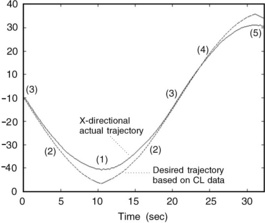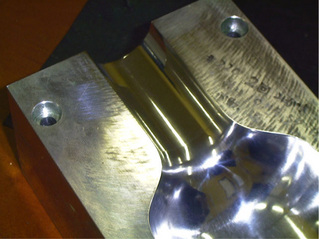Polishing robot for pet bottle blow molds
Abstract:
In this chapter, a CAD/CAM-based position/force controller in Cartesian space is presented for a mold polishing robot. CL data with normal vectors are referred to as not only the desired trajectory of tool translational motion but also the desired contact direction given to a mold surface, so that a complete non-taught operation of both position and contact direction can be realized. The controller also regulates the polishing force consisting of the contact force and kinetic friction forces. When the robot carries out polishing tasks, the position control loop delicately contributes to the force control loop to achieve both a regular pick feed control along CL data and a stable polishing force control on curved surface. The effectiveness and promise of the polishing robot is proved by actual polishing experiments using an industrial robot YASKAWA MOTOMAN UP6.
6.1 Background
Recently, open-architecture industrial robots, whose kinematics and servo system are technically opened, have been developed. Using such a robot we can explore new skillful applications without conventional complicated teaching. In the previous section, a 3D robot sander was introduced for the furniture manufacturing industry. The robot sander realized a non-taught operation regarding the position and orientation of the sanding tool attached to the robot arm.
As the next stage, we attempt to apply an industrial robot to the polishing process of PET(Poly Ethylene Terephthalate) bottle blow molds. As can be guessed, the size of the target workpieces are smaller than parts used in constructing furniture. That means the radius of curvature is also smaller. In the PET bottle molds manufacturing industry, 3D CAD/CAM systems and machining centers are being used widely, and these advanced systems have drastically rationalized the design and manufacturing process of metallic molds. On the contrary, the almost polishing process after machining process has been supported by skilled workers who have capabilities concerning both dexterous force control and skillful trajectory control for an abrasive tool. The skilled workers usually use mounted abrasive tools with several sizes and shapes. In using these types of tools, keeping contact with the metallic workpiece with a desired contact force and a tangential velocity is the most important factor to obtain a high-quality surface. When performing a polishing task, it is also a key point that skilled workers reciprocatingly move the abrasive tool back and forth along the object surface.
Generally, since the repetitive position accuracy at the tip of articulated-type industrial robots is 0.1 mm or within its neighborhood [65], it is very difficult to polish the surface of the metallic mold using only a position control strategy. In the polishing process of PET bottle molds, a surface accuracy Ra (arithmetical mean roughness) of 0.1 μm or less is finally required for mirror-like finishing. Especially, when an industrial robot makes contact with a metallic workpiece, several factors that decrease the total stiffness of the system are involved. They are called clearance, strain and deflection, all of which exist in not only the robot itself but also in the force sensor, abrasive tool, jig, base frame and so on. Therefore, it is meaningless to discuss the position accuracy at the tip of the abrasive tool attached to the robot arm. If a position control only is used for a polishing task where an abrasive tool and metallic workpiece contact to each other, then both the stiffness of the robot itself and the total stiffness including the abrasive tool must be extremely high. However, it would be really beyond our power and also the uncertainty of workpiece positioning would not be covered.
Up to now, several robots in which force control methods are implemented have been developed; they have allowed us to achieve successful automations required in each manufacturing process. For example, polishing robots and finishing robots were presented in [37,38]. In [37], a dynamic model that describes the dynamic behavior of the robot for surface finishing tasks is developed. Also, a robotic surface finishing system based on a planar robot with a force sensor and a deburring tool is proposed. In [38], the process development of a robotic system for automatically grinding and polishing vane airfoils is reported. However, each paper suggests that it is not easy to flexibly achieve the target tasks by using only the force control method. The difficulty is clear from the results that special hardware mechanisms such as manipulators, tools, sensors and measuring systems have been considered according to each manufacturing process. There also exists a serious problem that should be overcome at the present stage. When a polishing robot is designed, an end-effector with a force sensor is proposed for polishing; however, friction force acting between the end-effector and workpiece has not been successfully handled. The friction force in mold polishing has large effect on the quality and efficiency. Unfortunately, curved surfaces with large curvatures must be addressed in the case of polishing PET bottle molds, so that the required goal is considerably higher than the already introduced furniture sanding robot. Additionally, when a force-controlled robot contacts with a stiff environment such as a metallic mold, dynamic stability issues should be dealt with [19]. The force control system becomes unstable with the increase in stiffness.
It is known that no advanced polishing robots have been successfully developed yet on a commercial basis for such metallic molds with curved surfaces as PET bottle blow molds, due to the poor polishing quality and the complicated operation. The reasons why conventional polishing robots based on an industrial robot could not satisfactorily finish the curved surface of molds are as follows:
1. Conventional industrial robots provide only a teaching pendant as a user-interface device. Precise teaching along a curved surface is extremely difficult and complicated.
2. Kinematics and servo control, which are indispensable to develop a real-time application for mold polishing, have not been technically opened to engineers and researchers.
3. No successful control strategy has been proposed yet for mold polishing with curved surface. Compatibility between force control and position control is need for higher surface quality.
In this subsection, dexterous techniques are presented for realizing a skillful mold polishing robot as shown in Fig. 6.1. Normalized tool vectors are first generated from three-axis CL data. The CL data with normal vectors called multi-axis CL data can be used for not only a desired trajectory of tool translational motion but also contact directions given to a mold. The impedance model following force control method adjusts the polishing force composed of a contact force and kinetic friction force. A CAD/CAM-based position/force controller in Cartesian space by referring such multi-axis CL data is proposed for the polishing robot with a ball-end abrasive tool. The surface polishing is achieved by controlling both the tool position along the CL data and the polishing force. The differences with the block diagram shown in Fig. 4.4 are that the orientation of the tool is always fixed to z-axis in work coordinate system; the orientation component in CL data is used for the force direction to be given to a mold. The CAD/CAM-based position/force controller is applied to an industrial robot with an open-architecture controller. The effectiveness and validity of a mold polishing robot with the CAD/CAM-based position/force controller are demonstrated through actual polishing experiments.
6.2 Generation of multi-axis cutter location data
Although high-end 3D CAD/CAM systems generally have the multi-axis function, ordinary CAD/CAM systems do not support the function. When the 3D CAD/CAM used has no multi-axis functions, multi-axis CL data cannot be generated. In this subsection, we describe how to construct multi-axis CL data from three-axis ones. The multi-axis CL data are composed of position and normalized tool vectors. The three-axis CL data have position vectors p(i) = [px(i) py(i) pz(i)]T along the tool motion in work coordinate system, where i denotes the i-th step in CL data. Fig. 6.2 shows the generation image of normal vector n(i) at p(i). First of all, a direction vector t(i) = [tx(i) ty(i) tz(i)]T which represents the tool moving direction is given by
Next, p(i + j)(1 ≤ j ≤ 100), which is the nearest point to p(i), is searched. Another vector s(i) = [sx(i) sy(i) sz(i)]T is obtained by
Note here that j is selected so that t(i) and s(i) are not parallel to each other. The normalized tool vector n(i) = [nx(i) ny(i) nz(i)]T at p(i) on the free-formed surface is perpendicular to both t(i) and s(i), so that it yields the following relations:
n(i) is calculated from Eqs. (6.3), (6.4), (6.5) and (6.6). The multi-axis CL data CL(i) = [pT(i) nT(i)]T (i = 1, 2, 3, ![]() , l) which have information of normal direction can be composed by applying the above operations to all steps in three-axis CL data. l is the total number of steps in CL data. When the polishing robot runs, p(i) and n(i) are used to calculate the references of position and contact direction given to curved surface, respectively. The multi-axis CL data allow the polishing robot to simply realize a non-taught operation of position and contact direction. Desired position xd(k) and desired contact direction od(k) at the discrete time k are similarly obtained as explained in the sections 4 and 5. The position/force controller described in next section refers xd(k) and od(k) as desired values given to a ball-end abrasive tool, respectively.
, l) which have information of normal direction can be composed by applying the above operations to all steps in three-axis CL data. l is the total number of steps in CL data. When the polishing robot runs, p(i) and n(i) are used to calculate the references of position and contact direction given to curved surface, respectively. The multi-axis CL data allow the polishing robot to simply realize a non-taught operation of position and contact direction. Desired position xd(k) and desired contact direction od(k) at the discrete time k are similarly obtained as explained in the sections 4 and 5. The position/force controller described in next section refers xd(k) and od(k) as desired values given to a ball-end abrasive tool, respectively.
6.3 Basic Polishing Scheme for a Ball End Abrasive Tool
In this section, a control strategy efficiently using the contour of a ball-end abrasive tool is introduced for the mold polishing with curved surface. In polishing, the polishing force acting between the abrasive tool and target mold is controlled. The polishing force is the most important physical factor that largely affects the quality of polishing, and assumed to be the resultant force of contact and kinetic friction forces.
The image of the proposed mold polishing robot is shown in Fig. 6.1, in which a ball-end abrasive tool with a radius of 5 mm is attached to the tip of a six-DOFs articulated industrial robot through a force sensor. The abrasive tool is generally attached to a portable electric sander, so that the power of polishing is obtained by its high rotational motion, e.g., 10,000 rpm. In this case, however, it is so difficult for skilled workers to suitably keep regulating the power, contact force and tangential velocity for many minutes according to object’s shapes, i.e., undesirable over-polishing tends to occur frequently. Thus, to protect the mold surface against over-polishing, the proposed polishing robot keeps the rotation of the tool fixed, and polishes the workpiece using the resultant force Fr of the Coulomb friction and the viscous friction. Each friction force is generated by the contact force f = [fx fy fz]T in normal direction and the tangential velocity υt = [υtx υty υtz]T, respectively. Fig. 6.3 shows the control strategy taking account of the kinetic friction forces. In this figure, f is given by the normal velocity υn = [υnx υny υnz]T at the contact point between the abrasive tool and mold. υn is yielded by the IMFFC given by Eq. (1.17).
In this chapter, the polishing force is defined as the resultant force of Fr and f, which can be measured by a force sensor. Fig. 6.4 shows an example of force sensor, ATI Mini40 six-DOFs force/torque sensor. It is assumed that the polishing is performed by a hybrid control of the tool position and polishing force. In order to avoid the interference between the abrasive tool and mold, the orientation of the tool is not changed and always fixed to z-axis in work coordinate system. Fortunately, since PET bottle blow molds have no over hang, a suitable contact point between the ballend abrasive tool and the mold can be always obtained. The proposed polishing robot does not need to use any complex tools, vision sensors and jigs, so that it can be realized in a simple manner.
6.4 Feedback Control of Polishing Force
As mentioned above, if it is assumed in polishing that the friction force Fr acting on the abrasive tool is mainly composed of Coulomb and viscous frictions, then Fr is represented by Eq. (4.9). The polishing force assumed in the previous section is obtained by the resultant force of the contact force f (k) in normal direction and the friction force Fr (k) in tangential direction. The force vector F(k) = [Fx(k) Fy(k) Fz(k)]T measured by the force sensor as shown in Fig. 6.4 is regarded as the polishing force, so that it can be also written by Eq. (4.10). The polishing force given by Eq. (4.10) is controlled by the IMMFC given by Eq. (1.17). In the proposed mold polishing robot, the IMFFC is applied only in normal direction at the contact point, and the control law yields a velocity υnormal (k) given by Eq. (4.13). Using the υnormal(k) and normal direction vector od(k) included in Eq. (3.1), the normal velocity vector υn(k) to control the polishing force is obtained from Eq. (4.14).
6.5 Feedforward and Feedback Control of Tool Position
Currently, the molds for PET bottle manufacturing are designed and machined with 3D CAD/CAM systems and machining centers, respectively. Accordingly, multi-axis CL data or three-axis CL data generated from the main processor of the CAM can be used for the desired trajectory of an abrasive tool. If only three-axis CL data can be generated, normal direction vectors needed are obtained by a simple calculation described in section 7.2. The block diagram of the CAD/CAM-based position/force controller implemented in the mold polishing robot is almost same as Fig. 4.4, except the tool axis is always fixed to z-axis in work coordinate system. In other words, the tool orientation is not made to change in order to keep the force control stability and to uniformly abrade the contour of the ball-end abrasive tool.
The position of the abrasive tool is feedforwardly controlled by the tangential velocity vt(k) given by
where υtangent is a velocity norm which means the feed rate.υt(k) is given through an open-loop action so as not to interfere with the normal velocity υn(k). On the other hand, the polishing force is regulated by υn(k) which is perpendicular to υt(k). υn(k) is given to the normal direction referring od(k). It should be noted, however, that using only υt(k) is not enough to execute desired trajectory control along the CL data, i.e., the tool would not be able to conduct regular pick feed motion, e.g., with a given pick feed of 0.1 mm. To avoid this undesirable phenomenon, a simple position feedback loop with a small gain is added as shown in Fig. 4.4 so that the abrasive tool does not deviate from the desired pick feed motion. The position feedback control law generates another velocity υp(k) given by Eq. (4.15). Finally, the velocities υn(k), υt(k) and υp(k) are summed up, which is given to the reference of the Cartesian-based servo controller of the industrial robot. The CAD/CAM-based position/force controller deals with neither the moment nor rotation, and also the origin of the constraint space (force space) is always chosen at the contact point. Accordingly, although a paper by Duffy [66] states the fallacy of modern hybrid control theory such as dimensional inconsistency, dependence on the choice of origin of the coordinates, our proposed system is not affected at all.
6.6 Update timing of CL data
Here, we describe how to update the current step i of the CL data, i.e., defining the next step as i + 1, to realize a smooth feed motion. The main-processor of the CAM generally produces the CL data CL(i) = [pT(i) nT(i)]T so as to machine a workpiece within a given tolerance to a designed model. p(i) = [px(i) py(i) pz(i)]T and n(i) = [nx(i) ny(i) nz (i)]T (i = 1,2,…, l: l is the number of steps) are the position and normal direction components, respectively. Figure 6.5 shows an image of the proposed polishing strategy where the tool contour is efficiently utilized. One of the key points is that the tool does not go up over the situation (1) or (5) shown in Fig. 6.5 in order to avoid an undesirable over-polishing around the edges of the workpiece. The positions of the situation (1) and (5) are called the max-height. Another key point is that the tool axis is always fixed to z-axis in the work coordinate system to efficiently abrade the contour of the ball-end abrasive tool. Actually, the tangential velocity of the ball-end abrasive tool is linearly calculated based on the following direction vector.
If the CL data are used in the robotic controller, it is very important to realize a smooth feed motion that how to determine the timing of reading the next step i + 1, i.e., when the step number i should be updated. From now on, the following three conditions are evaluated.
a). Detection of the current position x(k) of tool tip
b). Consideration of the force measurement in normal direction besides the condition a).
c). Detection of the sum of the manipulated variable υt(k) given to the servo controller
Concerning the condition a), when the tool tip x(k) becomes out of [p(i),p(i + 1)], i.e., x(k) reaches to p(i + 1), i is updated. However, it does not work well around the situations (1) and (5) in Fig. 6.5. The reason is that the constraint caused by a contact between the tool contour and the workpiece prevents the tool tip from reaching to the next step p(i + 1). For example, even if the tool tip approaches to the point A in situation (5) through (4), it can not arrive at the point B. Consequently, the next step is not read out.
In the condition b), to solve the problem, the force measurement is further considered in addition to the condition a). In other words, when a large x-directional force such as |Fx| > Fd is detected, then the next step is immediately read in. In this case also, however, incorrect detections tend to occur. This is because the force control system in the finishing robot is a so-called high gain system,:its stiffness in the tool contact direction is about 120 N/mm, so that an undesirable spike over Fd sometimes breaks out.
Through the trial and error mentioned above, the condition c) is now introduced. In the condition c), if the following equation is satisfied, then i is updated to i + 1.
where ki is the discrete time when the last updating is conducted. In Eq. (6.9), when the sum of the value of manipulated variable in the tangential direction, which has been given to the servo system after the last updating, goes beyond the current distance ||t(i)|| between two adjacent steps, i is updated to i + 1. Calculating the update timing by using Eq. (6.9), the feed motion can be smoothly carried out even under the constrained situations (1) and (5) shown in Fig. 6.5.
6.7 Experiment
6.7.1 Experimental setup
To evaluate the validity and effectiveness of the mold polishing robot using the CAD/CAM-based position/force controller, a fundamental polishing experiment is conducted using an aluminum mold machined by a machining center as shown in Fig. 6.6. The main objective of the fundamental polishing is to remove all cusp marks on the curved surface whose heights are roughly 0.3 mm. The fundamental polishing before the finishing process is one of the most important processes to make the best-quality, mirror-like surface finishing. If the undesirable cusp marks are not uniformly removed in advance, then it is very difficult to finish the mold with a mirror-like surface without scratches, swells and over-polishing however much time would be spent for the finishing process.
Fig. 6.7 shows the mold polishing robot developed based on an industrial robot YASKAWA MOTOMAN UP6 with open control architecture used in the polishing experiment. The industrial robot provides several useful Windows API functions such as a Cartesian-based servo control and kinematics. A ball-end abrasive tool is attached to the tip of the robot arm via a force sensor. The robot also has a tiltable jig to incline the workpiece flexibly, and an oil mist to clean the surface of the mold and abrasive tool.
6.7.2 Polishing condition and experiment
An aluminum mold is fixed along the y-axis in robot work coordinate system with a tiltable jig. The mold is inclined by 45 degrees about the x-axis. One of the CL data used was generated with a zigzag path along the cross section as shown in Fig. 6.8(a). Mounted abrasive tools are usually attached to a portable electric sander, whose torque makes the abrasive tools rotate. When skilled workers manually use an electrically-driven tool swuch as this, the contact force is given under about 10 N. On the other hand, when a skilled worker polishes a mold by friction forces using a simple bamboo stick covered with a sand paper, the contact force is given as from about 10 to 40 N. In this experiment, since the rotation of the mounted abrasive tool is locked and the polishing task is conducted using the contact and kinetic friction forces, the desired polishing force is set to 20 N. Locking the rotation of the tool reduces undesirable high-frequency vibrational noises which are one of the serious problems in the case of locating the force sensor between the tip of the robot arm and the abrasive tool. The force values sensed every 125 μsec were filtered with a cutoff frequency of 500 Hz.
The surface was polished through three steps, making the grain size of the abrasive tool smaller gradually, i.e., from #220, #320 to #400. To obtain a higher quality surface, another zigzag path as shown in Fig. 6.8(b) was also used for the basic trajectory of the abrasive tool. These two paths shown in 6.8 were used alternately. Fig. 6.9 shows the polishing scene using the proposed robot. When the polishing robot runs, the abrasive tool is made to reciprocatingly rotate with ± 40 deg/sec using the sixth axis of the robot so that the contour can be abraded uniformly. If the abrasive tool is uniformly abraded keeping the ball-end shape, the robot can keep up the initial performance of polishing. Although the tool length gradually becomes shorter due to the tool abrasion, the force controller absorbs the uncertainty of tool length. Other polishing conditions in the case of using the path shown in Fig. 6.8(a) are tabulated in Table 6.1. As can be seen from the values of the force and position feedback gains, the y-directional position feedback loop delicately contributes to the force feedback loop in order to keep the constant pick feed even around the inclination part shown in Fig. 6.9.
Table 6.1
Polishing conditions in the case of using the path shown in Fig. 6.8(a)
| Conditions | Values |
| Robot | YASKAWA MOTOMAN UP6 |
| Force sensor | NITTA IFS-67M25A |
| Zigzag path along curved surface | Cross section |
| Pick feed in longitudinal direction | 0.2 mm |
| Radius of abrasive tool R | 5 mm |
| Grit size of abrasive tool | #220, #320, #400 |
| Rotational velocity of 6-th axis | 40 or –40 deg/s |
| Rotational limits of 6-th axis | –90 < θ6 < 90 deg |
| Desired polishing force Fd | 20 N |
| Tangent directional velocity ||υt|| | 8 mm/s |
| Desired mass coefficient Md | 0.01 N · s2/mm |
| Desired damping coefficient Bd | 30 N · s/mm |
| Force feedback gain Kf | 1 |
| Force integral control gain Ki | 0.0001 |
| Position feedback gain Kυx, Kυy, Kυz | 0, 0.02, 0 |
| Sampling time ∆t | 10 ms |
6.7.3 Compliant motion of a ball-end abrasive tool
The CAD/CAM-based position/force controller allows the polishing robot to perform a compliant motion so as not to damage the mold surface as illustrated in Fig. 6.10. The CL data shown in Fig. 6.10 are extracted from Fig. 6.8(a). First of all, the abrasive tool approaches to the initial contact point (3) with a low speed of 1 mm/s from a just above point. The position/force controller immediately becomes active when a contact occurs, i.e., the force sensor detects a small value more than 2 N in z-direction. Then, the abrasive tool starts a trajectory-tracking motion along the CL data. As can be seen from Fig. 6.10, the force controller absorbs position errors in x-direction caused by the radius of the abrasive tool; the higher the tool position, the larger the position error between the CL data and actual trajectory. If the tip of the abrasive tool moves stiffly along the CL data, then the mold or tool would be fractured. Fig. 6.11 shows an x-directional actual trajectory acquired from an experiment in which the CL data as shown in Fig. 6.10 were used in the cross section and ||υt||was set to 6 mm/s. It is observed from this result that the abrasive tool attached to the tip of the robot arm was controlled with a desirable compliance in x-direction. Of course, such compliant motion also works well in the other two directions according to the shape of mold.
6.7.4 Experimental result
It was confirmed that the significant resolution in the force domain was almost about 1.2 N with a position resolution of 0.01 mm in the case that the repetitive position accuracy at the tip of the abrasive tool shown in Fig. 6.1 was about 0.1 mm [65]. Although the force resolution is not so fine compared with skilled workers taking charge of the mold polishing process, the polishing robot can perform each task more uniformly and stably for many hours. The surface state after polishing was evaluated by both eye checking and touch feeling with fingers, and consequently a successful surface without over-polishing around the edges was observed. Furthermore, we conducted a quantitative evaluation using a stylus instrument, so that the measurements obtained by the arithmetical mean roughness (Ra) and maximum depth (Ry) were around 0.1 μm and 1.6 μm, respectively. It can be seen from the result that the polishing force could be more uniformly given to the surface on the average compared to skilled workers due to the proposed position/force controller. This is a main reason why such an effective polishing quality was obtained drastically. Fig. 6.12 shows the curved surface after being wiped with a cloth containing a polishing compound Cr2O3.
6.8 Conclusion
Up to now, it has been widely discussed and believed in manufacturing industries of metallic molds that it would be impossible for articulated-type industrial robots, whose position accuracy is 0.1 mm at most, to polish and finish metallic molds with curved surfaces. However, our proposed polishing robot could satisfactorily overcome this problem due to the CAD/CAM-based position/force controller.
In this chapter, we have proposed a CAD/CAM-based position/force controller in Cartesian space for a mold polishing robot. The CL data with normal vectors are referred to as not only the desired trajectory of tool translational motion but also the desired contact direction given to molds, so that a complete non-taught operation of both position and contact direction can be realized. The controller also regulates the polishing force consisting of the contact force and kinetic friction forces. When the robot carries out polishing tasks, the position control loop delicately contributes to the force control loop to achieve both a regular pick feed control along the CL data and a stable polishing force control on curved surface. The effectiveness and promise of the polishing robot using the CAD/CAM-based position/force controller have been proved by actual polishing experiments using an industrial robot YASKAWA MOTOMAN UP6.
References
[1] Chen, C., Trivedi, M.M., Bidlack, C.R. Simulation and animation of sensor-driven robots. IEEE Trans. on Robotics and Automation. 1994; 10(5):684–704.
[2] Benimeli, F., Mata, V., Valero, F. A comparison between direct and indirect dynamic parameter identification methods in industrial robots. Robotica. 2006; 24(5):579–590.
[3] Corke, P. A Robotics Toolbox for MATLAB. IEEE Robotics & Automation Magazine. 1996; 3(1):24–32.
[4] Corke, P. MATLAB Toolboxes: robotics and vision for students and teachers. IEEE Robotics & Automation Magazine. 2007; 14(4):16–17.
[5] Luh, J.Y.S., Walker, M.H., Paul, R.P.C. Resolved acceleration control of mechanical manipulator. IEEE Trans. on Automatic Control. 1980; 25(3):468–474.
[6] Nagata, F., Kuribayashi, K., Kiguchi, K., Watanabe, K. Simulation of fine gain tuning using genetic algorithms for model-based robotic servo controllers. IEEE International Symposium on Computational Intelligence in Robotics and Automation. 2007; 196–201.
[7] Nagata, F., Okabayashi, I., Matsuno, M., Utsumi, T., Kuribayashi, K., Watanabe, K., Fine gain tuning for model-based robotic servo controllers using genetic algorithms. 13th International Conference on Advanced Robotics. 2007:987–992.
[8] Hogan, N. Impedance control: An approach to manipulation: Part I - Part III. Transactions of the ASME, Journal of Dynamic Systems, Measurement and Control. 1985; 107:1–24.
[9] Nagata, F., Watanabe, K., Hashino, S., Tanaka, H., Matsuyama, T., Hara, K., Polishing robot using a joystick controlled teaching system. IEEE International Conference on Industrial Electronics, Control and Instrumentation. 2000:632–637.
[10] Craig, J.J. Introduction to ROBOTICS —Mechanics and Control Second Edition—. Addison Wesley Publishing Co., Reading, Mass; 1989.
[11] Nagata, F., Kusumoto, Y., Fujimoto, Y., Watanabe, K. Robotic sanding system for new designed furniture with free-formed surface. Robotics and Computer-Integrated Manufacturing. 2007; 23(4):371–379.
[12] Kawato, M. The feedback-error-learning neural network for supervised motor learning. In: Advanced Neural Computers. Elsevier Amsterdam; 1990:365–373.
[13] Nakanishi, J., Schaal, S. Feedback error learning and nonlinear adaptive control. Neural Networks. 2004; 17(10):1453–1465.
[14] Furuhashi, T., Nakaoka, K., Maeda, H., Uchikawa, Y. A proposal of genetic algorithm with a local improvement mechanism and finding of fuzzy rules. Journal of Japan Society for Fuzzy Theory and Systems. 1995; 7(5):978–987. [(in Japanese)].
[15] Linkens, D.A., Nyongesa, H.O. Genetic algorithms for fuzzy control part 1: Offline system development and application. IEE Proceedings Control Theory and Applications. 1995; 142(3):161–176.
[16] Linkens, D.A., Nyongesa, H.O. Genetic algorithms for fuzzy control part 2: Online System Development and Application. IEE Proceedings Control Theory and Applications. 1995; 142(3):177–185.
[17] Ferretti, G., Magnani, G., Zavala Rio, A. Impact modeling and control for industrial manipulators. IEEE Control Systems Magazine. 1998; 18(4):65–71.
[18] Sasaki, T., Tachi, S. Contact stability analysis on some impedance control methods. Journal of the Robotics Society of Japan. 1994; 12(3):489–496. [(in Japanese)].
[19] An, H.C., Hollerbach, J.M., Dynamic stability issues in force control of manipulators. IEEE International Conference on Robotics and Automation. 1987:890–896.
[20] An, H.C., Atkeson, C.G., Hollerbach, J.M., Model-based control of a robot manipulatorThe MIT Press classics series. Massachusetts: The MIT Press, 1988.
[21] Takagi, T., Sugeno, M. Fuzzy identification of systems and its applications to modeling and control. IEEE Transactions Systems, Man & Cybernetics. 1985; 15(1):116–132.
[22] Nagata, F., Watanabe, K., Sato, K., Izumi, K., An experiment on profiling task with impedance controlled manipulator using cutter location data. IEEE International Conference on Systems, Man, and Cybernetics. 1999:848–853.
[23] Nagata, F., Watanabe, K., Izumi, K., Furniture polishing robot using a trajectory generator based on cutter location data. IEEE International Conference on Robotics and Automation. 2001:319–324.
[24] Raibert, M.H., Craig, J.J. Hybrid position/force control of manipulators. Transactions of the ASME, Journal of Dynamic Systems, Measurement and Control. 1981; 102:126–133.
[25] Nagata, F., Hase, T., Haga, Z., Omoto, M., Watanabe, K. CAD/CAM-based position/force controller for a mold polishing robot. Mechatronics. 2007; 17(4/5):207–216.
[26] Nagata, F., Watanabe, K., Hashino, S., Tanaka, H., Matsuyama, T., Hara, K. Polishing robot using joystick controlled teaching. Journal of Robotics and Mechatronics. 2001; 13(5):517–525.
[27] Nagata, F., Watanabe, K., Kiguchi, K. Joystick teaching system for industrial robots using fuzzy compliance control. Industrial Robotics: Theory, Modelling and Control, INTECH, pages. 2006; 799–812.
[28] Maeda, Y., Ishido, N., Kikuchi, H., Arai, T., Teaching of grasp/graspless manipulation for industrial robots by human demonstration. IEEE/RSJ International Conference on Intelligent Robots and Systems. 2002:1523–1528.
[29] Kushida, D., Nakamura, M., Goto, S., Kyura, N. Human direct teaching of industrial articulated robot arms based on force-free control. Artificial Life and Robotics. 2001; 5(1):26–32.
[30] Sugita, S., Itaya, T., Takeuchi, Y. Development of robot teaching support devices to automate deburring and finishing works in casting. The International Journal of Advanced Manufacturing Technology. 2003; 23(3/4):183–189.
[31] Ahn, C.K., Lee, M.C., An off-line automatic teaching by vision information for robotic assembly task. IEEE International Conference on Industrial Electronics, Control and Instrumentation. 2000:2171–2176.
[32] Neto, P., Pires, J.N., Moreira, A.P., CAD-based offline robot programming. IEEE International Conference on Robotics Automation and Mechatronics. 2010:516–521.
[33] Ge, D.F., Takeuchi, Y., Asakawa, N. Automation of polishing work by an industrial robot, – 2nd report, automatic generation of collision-free polishing path –. Transaction of the Japan Society of Mechanical Engineers. 1993; 59(561):1574–1580. [(in Japanese)].
[34] Ozaki, F., Jinno, M., Yoshimi, T., Tatsuno, K., Takahashi, M., Kanda, M., Tamada, Y., Nagataki, S. A force controlled finishing robot system with a task-directed robot language. Journal of Robotics and Mechatronics. 1995; 7(5):383–388.
[35] Pfeiffer, F., Bremer, H., Figueiredo, J. Surface polishing with flexible link manipulators. European Journal of Mechanics, A/Solids. 1996; 15(1):137–153.
[36] Takeuchi, Y., Ge, D., Asakawa, N., Automated polishing process with a human-like dexterous robot. IEEE International Conference on Robotics and Automation. 1993:950–956.
[37] Pagilla, P.R., Yu, B. Robotic surface finishing processes: modeling, control, and experiments. Transactions of the ASME, Journal of Dynamic Systems, Measurement and Control. 2001; 123:93–102.
[38] Huang, H., Zhou, L., Chen, X.Q., Gong, Z.M. SMART robotic system for 3D profile turbine vane airfoil repair. International Journal of Advanced Manufacturing Technology. 2003; 21(4):275–283.
[39] Stephien, T.M., Sweet, L.M., Good, M.C., Tomizuka, M. Control of tool/workpiece contact force with application to robotic deburring. IEEE Journal of Robotics and Automation. 1987; 3(1):7–18.
[40] Kazerooni, H. Robotic deburring of two-dimensional parts with unknown geometry. Journal of Manufacturing Systems. 1988; 7(4):329–338.
[41] Her, M.G., Kazerooni, H. Automated robotic deburring of parts using compliance control. Transactions of the ASME, Journal of Dynamic Systems, Measurement and Control. 1991; 113:60–66.
[42] Bone, G.M., Elbestawi, M.A., Lingarkar, R., Liu, L. Force control of robotic deburring. Transactions of the ASME, Journal of Dynamic Systems, Measurement and Control. 1991; 113:395–400.
[43] Gorinevsky, D.M., Formalsky, A.M., Schneider, A.Y. Force Control of Robotics Systems. New York: CRC Press; 1997.
[44] Takahashi, K., Aoyagi, S., Takano, M., Study on a fast profiling task of a robot with force control using feedforward of predicted contact position data. 4th Japan-France Congress & 2nd Asia-Europe Congress on Mechatronics. 1998:398–401.
[45] Takeuchi, Y., Watanabe, T. Study on post-processor for 5-axis control machining. Journal of the Japan Society for Precision Engineering. 1992; 58(9):1586–1592. [(in Japanese)].
[46] Takeuchi, Y., Wada, K., Hisaki, T., Yokoyama, M. Study on post-processor for 5-axis control machining centers —In case of spindle-tilting type and table/spindle-tilting type. Journal of the Japan Society for Precision Engineering. 1994; 60(1):75–79. [(in Japanese)].
[47] Xu, X.J., Bradley, C., Zhang, Y.F., Loh, H.T., Wong, Y.S. Tool-path generation for five-axis machining of free-form surfaces based on accessibility analysis. International Journal of Production Research. 2002; 40(14):3253–3274.
[48] Chen, S.L., Chang, T.H., Inasaki, I., Liu, Y.C. Postprocessor development of a hybrid TRR-XY parallel kinematic machine tool. The International Journal of Advanced Manufacturing Technology. 2002; 20(4):259–269.
[49] Lei, W.T., Hsu, Y.Y. Accuracy test of five-axis CNC machine tool with 3D probe-ball Part I: design and modeling. Machine Tool & Manufacture. 2002; 42(10):1153–1162.
[50] Lei, W.T., Sung, M.P., Liu, W.L., Chuang, Y.C. Double ballbar test for the rotary axes of five-axis CNC machine tools. Machine Tool & Manufacture. 2006; 47(2):273–285.
[51] Cao, L.X., Gong, H., Liu, J. The offset approach of machining free form surface. Part 1: Cylindrical cutter in five-axis NC machine tools. Journal of Materials Processing Technology. 2006; 174(1/3):298–304.
[52] Cao, L.X., Gong, H., Liu, J. The offset approach of machining free form surface. Part 2: Toroidal cutter in 5-axis NC machine tools. Journal of Materials Processing Technology. 2007; 184(1/3):6–11.
[53] Timar, S.D., Farouki, R.T., Smith, T.S., Boyadjieff, C.L. Algorithms for time optimal control of CNC machines along curved tool paths. Robotics and Computer-Integrated Manufacturing. 2005; 21(1):37–53.
[54] Heo, E.Y., Kim, D.W., Kim, B.H., Chen, F.F. Estimation of NC machining time using NC block distribution for sculptured surface machining. Robotics and Computer-Integrated Manufacturing. 2006; 22(5–6):437–446.
[55] Tarng, Y.S., Chuang, H.Y., Hsu, W.T. Intelligent cross-coupled fuzzy feedrate controller design for CNC machine tools based on genetic algorithms. International Journal of Machine Tools and Manufacture. 1999; 39(10):1673–1692.
[56] Zuperl, U., Cus, F., Milfelner, M. Fuzzy control strategy for an adaptive force control in end-milling. Journal of Materials Processing Technology. 2005; 164/165:1472–1478.
[57] Farouki, R.T., Manjunathaiah, J., Nicholas, D., Yuan, G.F., Jee, S. Variable-feedrate CNC interpolators for constant material removal rates along Pythagorean-hodograph curves. Computer-Aided Design. 1998; 30(8):631–640.
[58] Farouki, R.T., Manjunathaiah, J., Yuan, G.F. G codes for the specification of Pythagorean-hodograph tool paths and associated feedrate functions on open-architecture CNC machines. Machine Tools & Manufacture. 1999; 39(1):123–142.
[59] Frank, A., Schmid, A. Grinding of non-circular contours on CNC cylindrical grinding machines. Robotics and Computer-Integrated Manufacturing. 1988; 4(1/2):211–218.
[60] Couey, J.A., Marsh, E.R., Knapp, B.R., Vallance, R.R. Monitoring force in precision cylindrical grinding. Precision Engineering. 2005; 29(3):307–314.
[61] Tawakoli, T., Rasifard, A., Rabiey, M. Highefficiency internal cylindrical grinding with a new kinematic. Machine Tools & Manufacture. 2007; 47(5):729–733.
[62] Nagata, F., Kusumoto, Y., Hasebe, K., Saito, K., Fukumoto, M., Watanabe, K., Post-processor using a fuzzy feed rate generator for multi-axis NC machine tools with a rotary unit. International Conference on Control, Automation and Systems. 2005:438–443.
[63] Nagata, F., Watanabe, K. Development of a postprocessor module of 5-axis control NC machine tool with tilting-head for woody furniture. Journal of the Japan Society for Precision Engineering. 1996; 62(8):1203–1207. [(in Japanese)].
[64] Fujino, K., Sawada, Y., Fujii, Y., Okumura, S., Machining of curved surface of wood by ball end mill – Effect of rake angle and feed speed on machined surface. 16th International Wood Machining Seminar, Part 2. 2003:532–538.
[65] Nagata, F., Hase, T., Haga, Z., Omoto, M., Watanabe, K., Intelligent desktop NC machine tool with compliance control capability. 13th International Symposium on Artificial Life and Robotics. 2008:779–782.
[66] Duffy, J. The Fallacy of modern hybrid control theory that is based on orthogonal complements of twist and wrench spaces. Journal of Robotic Systems. 1990; 7(2):139–144.
[67] Lee, M.C., Go, S.J., Lee, M.H., Jun, C.S., Kim, D.S., Cha, K.D., Ahn, J.H. A robust trajectory tracking control of a polishing robot system based on CAM data. Robotics and Computer-Integrated Manufacturing. 2001; 17(1/2):177–183.
[68] Nagata, F., Mizobuchi, T., Tani, S., Hase, T., Haga, Z., Watanabe, K., Habib, M.K., Kiguchi, K., Desktop orthogonal-type robot with abilities of compliant motion and stick-slip motion for lapping of LED lens molds. IEEE International Conference on Robotics & Automation. 2010:2095–2100.
[69] Bilkay, O., Anlagan, O. Computer simulation of stick-slip motion in machine tool slideways. Tribology International. 2004; 37(4):347–351.
[70] Mei, X., Tsutsumi, M., Tao, T., Sun, N. Study on the compensation of error by stick-slip for high-precision table. International Journal of Machine tools & Manufacture. 2004; 44(5):503–510.
[71] Tsai, M.J., Chang, J.L., Haung, J.F., Development of an automatic mold polishing system. IEEE International Conference on Robotics & Automation. 2003:3517–3522.
[72] Tsai, M.J., Fang, J.J., Chang, J.L. Robotic path planning for an automatic mold polishing system. International Journal of Robotics & Automation. 2004; 19(2):81–89.
[73] Hocheng, H., Sun, Y.H., Lin, S.C., Kao, P.S. A material removal analysis of electrochemical machining using flat-end cathode. Journal of Materials Processing Technology. 2003; 140(1/3):264–268.
[74] Uehara, Y., Ohmori, H., Lin, W., Ueno, Y., Naruse, T., Mitsuishi, N., Ishikawa, S., Miura, T., Development of spherical lens ELID grinding system by desk-top 4-axes Machine Tool. International Conference on Leading Edge Manufacturing in 21st Century. 2005:247–252.
[75] Ohmori, H., Uehara, Y. Development of a desktop machine tool for mirror surface grinding. International Journal of Automation Technology. 2010; 4(2):88–96.
[76] Nagata, F., Hase, T., Haga, Z., Omoto, M., Watanabe, K. Intelligent desktop NC machine tool with compliant motion capability. Artificial Life and Robotics. 2009; 13(2):423–427.
[77] Nagata, F., Tani, S., Mizobuchi, T., Hase, T., Haga, Z., Omoto, M., Watanabe, K., Habib, M.K., Basic performance of a desktop NC machine tool with compliant motion capability. IEEE International Conference on Mechatronics and Automation, WC1-5. 2008:1–6.
[78] Nagata, F., Watanabe, K., Sato, K., Izumi, K. Impedance control using anisotropic fuzzy environment models. Journal of Robotics and Mechatronics. 1999; 11(1):60–66.
[79] Nagata, F., Otsuka, A., Yoshitake, S., Watanabe, K., Automatic control of an orthogonal-type robot with a force sensor and a small force input device. The 37th Annual Conference of the IEEE Industrial Electronics Society. 2011:3151–3156.
[80] Nagata, F., Watanabe, K. Feed rate control using a fuzzy reasoning for a mold polishing robot. Journal of Robotics and Mechatronics. 2006; 18(1):76–82.
[81] Nagata, F., Watanabe, K., Japanese Patent 4094781, Robotic force control method, 2008.
[82] Nagata, F., Tsuda, K., Watanabe, K., Japanese Patent 4447746, Robotic trajectory teaching method, 2010.
[83] Tsuda, K., Yasuda, K., Nagata, F., Kusumoto, Y., Watanabe, K., Japanese Patent 4216557, Polishing apparatus and polishing method, 2008.

